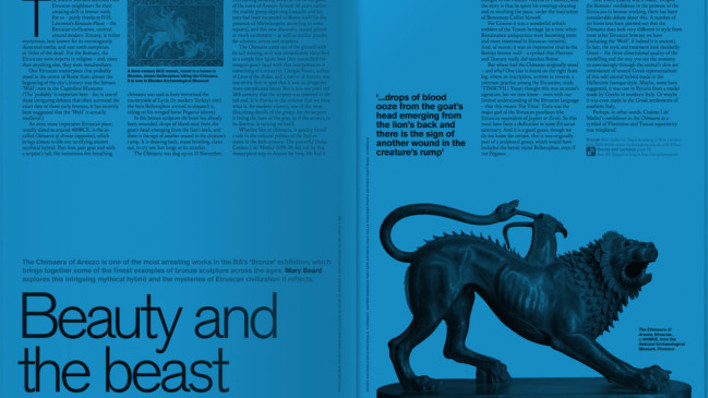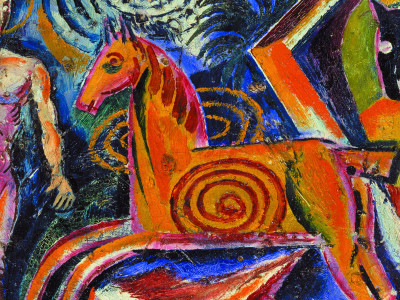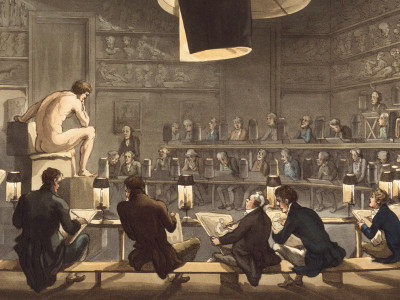
How does the RA judge art by children?
By Louise Benson
Published on 21 June 2023
The RA’s primary school panel talks with Louise Benson about the process behind assessing the thousands of entries for this year’s Young Artists’ Summer Show.
From the Summer 2023 issue of RA Magazine, issued quarterly to Friends of the RA.
What links a ceramic sculpture of a crocodile in a bread bun (Hot Croc), a coloured pencil drawing of a tomato locked in jail, and a digital sketch of a cat wearing a large pair of sunglasses? Welcome to the dizzyingly playful world of the Royal Academy’s Young Artists’ Summer Show, a free open submission exhibition for students aged 4–19 in the UK. Now in its fifth year, the exhibition receives more submissions than the Summer Exhibition, with this year’s cohort chosen from more than 21,000 entries. Approximately 250 artworks are displayed in a free exhibition in the RA’s Clore Learning Centre, hung by the same technicians who handle masterpieces by the likes of Matisse and Gainsborough. These works also appear in an online exhibition along with approximately 250 additional works.
There are two judging panels comprised of artists and curators, one for primary school students, the other for secondary. Each panel spends a day together on site at the Royal Academy reviewing digital images of the submissions. The young artists can submit works in any medium, from collage to found objects, video to textiles. When I meet the three judges of this year’s primary school panel, who assess the work of children as young as four and up to the age of eleven, they explain that the experience has been as rewarding as it has been challenging.

Hot Croc, 2023

Glasses, 2023

A Collection of Numbers, 2023

Tomato in the Jail, 2023
“The works have got the full range of emotion,” says Sarah Lea, RA exhibitions curator. “They are filled with real humour, and certain things that the children observe in the world, and the way that they express themselves.” Mary Stephenson, a final-year student at the RA Schools, adds: “Some of them are using art to grapple with very difficult experiences. We’ve got works depicting families who have been directly affected by the war in Ukraine, as well as others expressing the experience of migration from other countries.” “But then,” painter Mali Morris RA points out with a smile, “there is also just the day-to-day joy of everyday life, and the things that feature prominently in a child’s life, whether that be food, domestic life, pets or toys.”
What are they looking for from the submissions? “Originality, creativity and skill,” they agree. Each work is submitted with an accompanying explanatory statement, ranging from a single word to a more detailed description (these are later printed in the free exhibition catalogue and online). “They’re funny and poignant,” Lea says. “They offer the firsthand experience of these young people, which is very powerful.” A pencil drawing titled Gymy Pigs is accompanied by the following statement: “These are my guinea pigs Louis and Lou. I love imagining them working out at the gym.”

There is frequent uplifting laughter and shouts of delight from the judges as they alight upon each new creation, and Morris quotes the artist Terry Frost RA, who would check if an artwork gave him ‘a tickle’ as a measure of its greatness. One text-based artwork by Nico, aged 7, reads in bold lettering, “I don’t want to enter the Royal Academy art competition.” The accompanying statement reads: “This is how I felt when I was asked to do the submission for the art competition. But then I realised I did want to do it. Art is fun when you put your mind to it.” The judges are unanimous: “A straight yes from us.”

Other works engage with contemporary politics, as seen through the eyes of a child – a reminder of how current affairs and the domestic sphere collide in often surprising and emotional ways. A wooden door has been painted with the names of the prime ministers who have been in office during the child’s lifetime, measured alongside the height of the young artist as they grew up. There are five in total, a remarkable record of unprecedented political change. “It’s quite profound,” Stephenson says.
A pencil drawing titled Welcome shows a child encountering a policeman on the beach. “The UK government is trying to make it illegal for refugees to come to this country and will arrest them as soon as they arrive,” writes ten-year-old Rafaella, “but these are real people with feelings, hopes and dreams and that’s what this work is about.”
“It’s a place for children to address and explore these feelings, and it can be very moving,” Lea explains, before pausing. “But of course, you also have lots of pictures of cats, and that’s just as valid.” A number of works have taken inspiration from Royal Academicians, including Lubaina Himid and Frank Bowling, in paintings that fizz with colour and life, with one series inspired by Himid that the entrant painted on the interior of wooden drawers.

The show offers a springboard to the young artists, giving them a professional platform to experience what it means to exhibit publicly. “They are the next generation of artists, and the next generation of Academicians,” says Lea. “It’s important for us as an institution and educational establishment to celebrate that.”
The judges also reflect on what they themselves have learned from being immersed in the minds of these children for the day. “It reminds you of the open-ended nature of art making and world building, and the possibilities of mark making,” Stephenson says. “The works transport you and that’s really inspiring.” As Lea concludes, “We can’t wait for the public to come and see them, and to share in that sense of delight.”
Louise Benson is Director of Digital at Art Review.
Young Artists' Summer Show 2023 is at the Royal Academy of Arts from 18 July – 13 August 2023.

Enjoyed this article?
As well as free entry to all of our exhibitions, Friends of the RA enjoy one of Britain’s most respected art magazines, delivered directly to your door. Why not join the club?
Related articles

Why children’s art matters
8 July 2024

Visions from Ukraine
19 June 2024

10 RA Schools stories through the centuries
16 May 2024